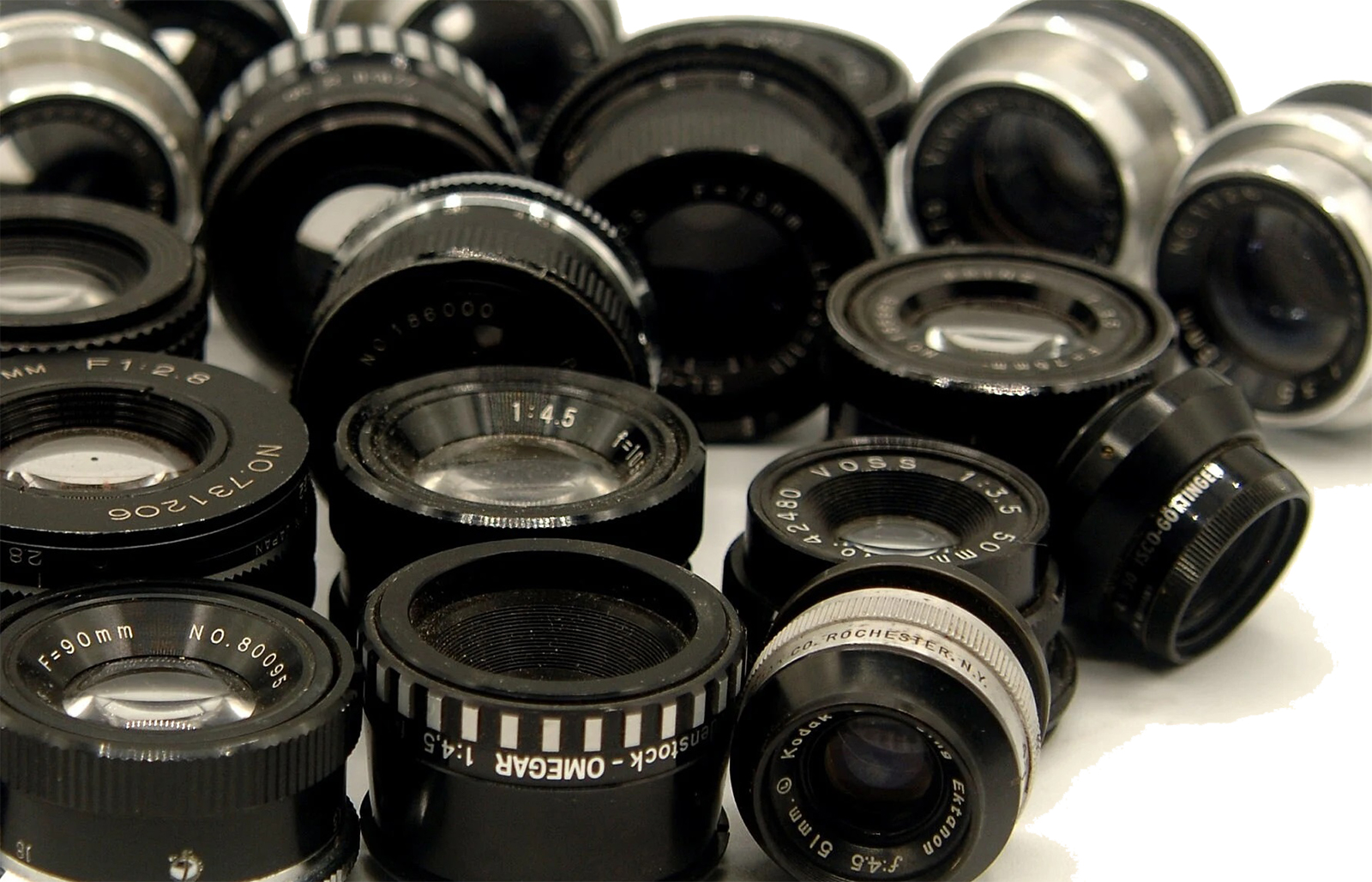In an era dominated by cutting-edge technology and the relentless pursuit of perfection, a growing community of filmmakers and photographers is turning their gaze back in time, seeking the charm of yesteryears.
So, are old camera lenses worth anything?
Old camera lenses can be valuable, especially if they’re from renowned brands or have unique characteristics. Their worth depends on factors like rarity, condition, and demand. While some vintage lenses fetch high prices, others are valued for their distinctive optical qualities rather than monetary worth.
With their unique imperfections and character, Vintage lenses have emerged as a sought-after tool for those looking to infuse their work with nostalgia and warmth. These lenses, relics from a bygone era, offer a distinctive aesthetic that modern optics often can’t replicate.
Join us as we explore the world of vintage lenses, guiding enthusiasts to discover, purchase, and utilize these timeless pieces in contemporary cinematography and photography and showcasing their relevance in today’s digital age.
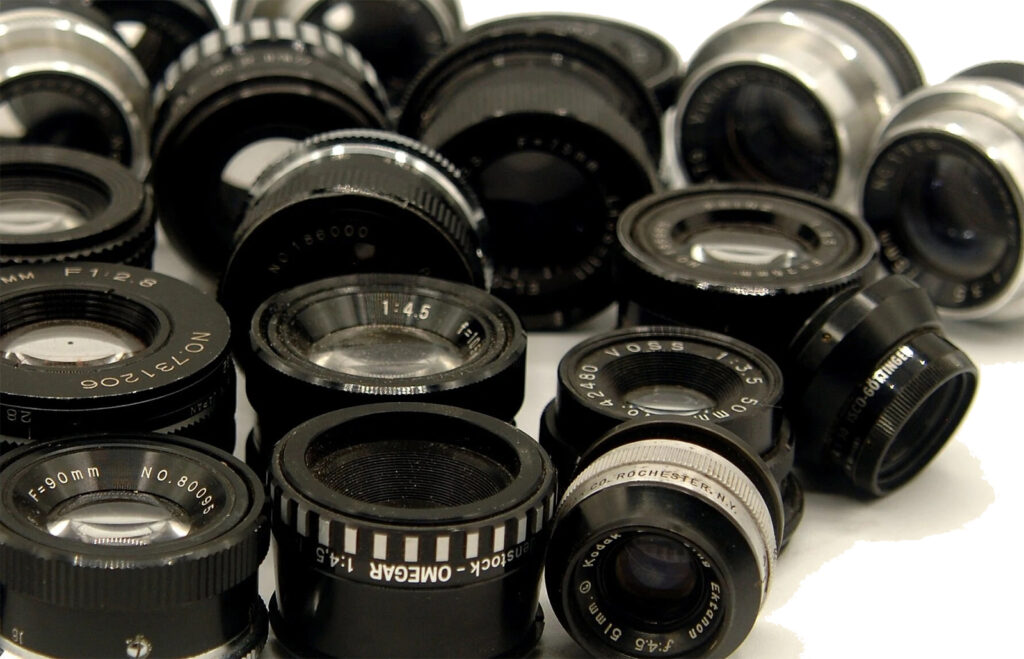
Value and Worth of Old Cameras and Lenses
In the intricate tapestry of photography’s history, old cameras and lenses hold a special place, often evoking nostalgia and reverence. But beyond their sentimental value, how do these vintage pieces fare in today’s market?
Are Old Camera Lenses Worth Anything?
Old camera lenses can be valuable, with some vintage lenses worth thousands due to their unique quality and results.
The age of a lens doesn’t necessarily determine its worth; instead, certain lenses have distinct characteristics that make them stand out and are considered legendary.
When comparing prices from 1981 to today, an Olympus OM-10 camera with a 50mm f/1.8 lens was priced at $197.95 in 1981, equivalent to $605.28 today. The modern equivalent, the OM-D E-M10, is priced at $699.00, as of writing this.
Similarly, the original OM-System Zuiko 24mm f/2.0 lens was priced at $354.95 in 1981, equivalent to $1,085.34 today. The modern equivalent, the Olympus M.Zuiko 12mm f/2.0, is priced at $799 today.
The value of a lens depends on various factors, including its rarity, desirability, and technological advancements.
Lenses designed in 1981 were manual, while modern lenses are electronic, supporting auto exposure and autofocus. Additionally, the complexity of lens design has evolved with the advent of computer-aided design, leading to more intricate and high-quality lenses.
- Lens Value Over Time The value of lenses has changed over the decades, with some vintage lenses appreciating due to their rarity and unique characteristics.
- Technological Advancements Modern lenses benefit from technological advancements, including computer-aided design, which allows for more complex and high-quality lens designs.
- Price Comparison When adjusted for inflation, the prices of some vintage lenses are comparable to their modern equivalents, while others may be more or less expensive.
Are Old Canon Cameras Worth Anything?
What about old cameras?!
Old Canon film cameras, especially those from the early 80s, hold sentimental value for many photography enthusiasts as they represent a significant period in the history of photography.
Aged Canon cameras, especially film cameras, represent a piece of history in photography. They serve as a reminder of the evolution of the craft and hold sentimental value for many enthusiasts.
These cameras, which span from the 1880s Kodak Brownie era to the turn of the 21st century, are seen as historical artifacts. While they might not be used for shooting anymore, they serve as a reminder of the evolution of photography.
Early Canon EOS digital cameras, even those dating back to 2000, are still functional and capable of producing quality images.
With the right lenses and maintenance, these cameras can offer great value for practicing photographic skills. The monetary value of these cameras varies, with some models fetching more on the collectors’ market than others.
Here’s some discussion and insights on the Canon community.
Vintage Lenses vs. Modern Lenses
The world of photography is a blend of evolving technology and timeless artistry. As we stand at the crossroads of past and present, a debate emerges: vintage lenses with their unique character or modern lenses with cutting-edge precision?
What Is Considered A Vintage Lens?
Vintage lenses have a unique charm and appeal that many photographers appreciate. These lenses often have a metal construction and offer a distinct look that modern lenses, designed for clinical precision, might not provide.
What is considered a vintage lens?
A vintage lens refers to camera optics from previous eras, often manufactured before the digital age. Typically, lenses over 20-30 years old are considered vintage. They’re valued for their unique construction, optical characteristics, and the distinctive images they produce, offering a look distinct from modern lenses.
Vintage lenses are known for their unique rendering, which can add a special touch to photos. Vintage lenses offer a distinct look that modern lenses might not achieve. This includes amazing bokeh, color rendition, and other optical characteristics.
When using vintage lenses, sharpness isn’t always the primary concern. Instead, photographers often seek the unique character and aesthetic these lenses bring. Vintage lenses might produce onion bokeh, which some find beautiful and adds to the overall look of an image.
While modern lenses are designed for utmost sharpness, vintage lenses prioritize character. The images they produce might not be the sharpest, but they have a unique aesthetic.
Another aspect of vintage lenses is that they encourage photographers to slow down. Many vintage lenses are manual focus, requiring more time and thought in composing a shot.
Using vintage lenses often means manual focusing and taking more time to compose a shot. This can be a refreshing change from the fast-paced nature of modern photography.
Lenses that are over 20 years old are typically considered vintage. This includes many lenses from the DSLR era from brands like Zeiss, Canon, Nikon, and others.
Why Use Vintage Lenses?
Using vintage lenses offers photographers and videographers a unique experience and several advantages.
While vintage lenses might not offer the convenience and technical perfection of modern lenses, they provide a unique experience and aesthetic that many photographers value.
Whether it’s for their distinctive image character, the tactile experience of manual focusing, or the joy of discovering and using a piece of photographic history, vintage lenses have a lot to offer.
Here are some reasons why you might choose to use vintage lenses:
- Distinctive Image Character: Vintage lenses often produce images with a unique character that modern lenses might not replicate. This can include softer focus, unique bokeh, lens flares, and a particular color rendition that adds a nostalgic or dreamy feel to photos.
- Cost-Effective: Vintage lenses can often be found at a fraction of the cost of modern lenses, especially if you’re looking for prime lenses with wide apertures. This makes them an affordable option for those on a budget.
- Build Quality: Many vintage lenses, especially those from renowned brands, are built with solid metal construction, making them durable and long-lasting.
- Manual Focus: Most vintage lenses are manual focus, which can benefit those who want to slow down and be more deliberate with their photography. Manual focusing can also be preferable for certain types of photography, like macro or some portraiture.
- Adaptability: With the advent of mirrorless cameras, it’s become easier to adapt vintage lenses from various brands to modern camera bodies using lens adapters. This opens up a world of possibilities for trying different lenses on your camera.
- Optical Imperfections: While modern lenses often aim for optical perfection, the imperfections in vintage lenses can be artistically appealing. These can include chromatic aberration, vignetting, and softness at wide apertures, adding a unique touch to images.
- Slows Down the Process: Using a vintage lens can slow down the photographic process, making photographers more thoughtful about composition, focus, and exposure. This can be a meditative and rewarding experience.
- Environmental Considerations: Buying and using vintage lenses is a form of recycling. Instead of always buying new gear, reusing old lenses can be an environmentally friendly choice.
- Historical Connection: Using vintage lenses can provide a connection to the history of photography, allowing photographers to experience and appreciate the tools and techniques of past generations.
- Learning Experience: Working with vintage lenses, especially with their manual settings, can be a great learning experience. It can help photographers understand the fundamentals of photography better and improve their skills.
Vintage Lens Vs. Modern Lens
For many modern photographers, the idea of using a vintage prime lens instead of a new autofocus lens might seem unconventional.
While vintage lenses offer a unique, nostalgic character, modern lenses provide technological advancements and optical precision. The choice between them often hinges on the desired aesthetic and project requirements.
Vintage Lenses
- Character: Often produce unique bokeh, flares, and color rendition not found in modern lenses.
- Construction: Typically robust, made with metal and glass.
- Manual Focus: Most vintage lenses lack autofocus capabilities.
- Imperfections: May introduce softness, vignetting, or chromatic aberration, which can be artistically desirable.
- Cost: Generally more affordable than modern counterparts, unless they’re rare or highly sought after.
Modern Lenses
- Sharpness: Engineered for precision, offering edge-to-edge sharpness.
- Technology: Often come with autofocus, image stabilization, and advanced lens coatings.
- Compatibility: Designed for modern camera mounts and sensors, ensuring optimal performance.
- Optical Corrections: Minimized lens aberrations, distortion, and other optical flaws.
- Price: Can be expensive, especially for lenses with advanced features or from premium brands.
Vintage Lens On DSLR And Digital Cameras
Often constructed with solid build quality and unique optical characteristics, Vintage lenses can be adapted to modern DSLR and digital cameras. The process involves using adapter rings that allow photographers to mount older film lenses onto their current camera bodies.
Using an aluminum adapter ring, an old Nikon lens can be adapted to fit a Canon 7D MkI. These adapters are affordable and can be bought from platforms like eBay.
While the lenses are manual, meaning both aperture and focus must be adjusted by hand, some adapters come with focus indicator chips that communicate to the camera when the desired focus point is achieved.
Using vintage lenses on modern cameras offers a deliberate approach to photography, encouraging photographers to be more thoughtful about their composition and settings.
Adapting vintage lenses to modern cameras can be a cost-effective way to access high-quality optics without breaking the bank.
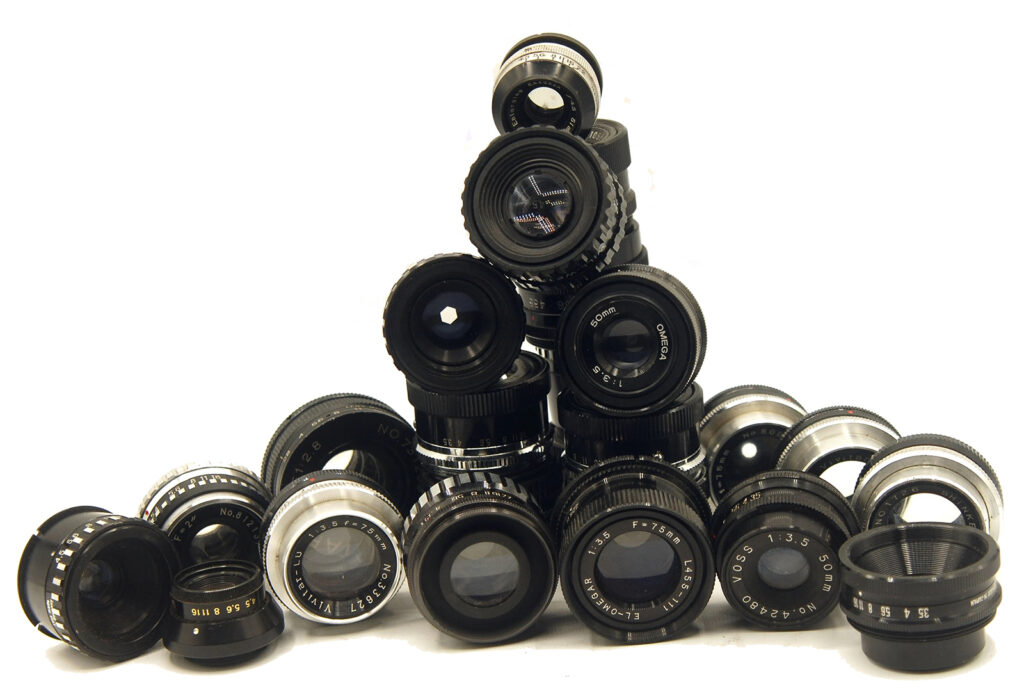
Vintage Lenses For Different Brands And Purposes
The allure of vintage lenses transcends mere nostalgia; it’s about the distinct visual stories they tell.
As various camera brands have evolved over the decades, so have the lenses that accompany them.
From the iconic to the obscure, join us in exploring the multifaceted universe of vintage lenses tailored for varied photographic endeavors.
Vintage Lenses For Canon
Canon has a rich history spanning nearly 90 years, producing a variety of cameras and lenses.
One of the earlier lens mounts for their single-lens reflex (SLR) cameras was the R mount, which later evolved into the more commonly known Canon FL and FD mounts.
Here are some of the most notable and best-performing Canon vintage lenses that can be adapted to most modern Canon systems and other mirrorless or DSLR cameras with compatible mount adapters.
Canon R Lenses
Mount: The Canon R mount was introduced in 1959 for Canon’s SLR cameras before the FL and FD mounts.
Lens Range: The R series had a limited range of lenses, as it was quickly succeeded by the FL mount in 1964.
Features: These lenses were manual focus with aperture control on the lens itself.
Compatibility: They were designed for Canon’s SLR cameras of that era, like the Canonflex.
- Canon R Super-Canomatic 58mm F/1.2 Lens: Released in 1962, this lens was marketed as one of the fastest lenses with a maximum aperture of f/1.2. It was the predecessor to some of the most famous Canon vintage lenses.
- Canon R Super-Canomatic 85mm F/1.8 Lens: Released in 1961, this lens was popular among professionals for its excellent qualities, especially for portrait photography.
- Canon R Super Canomatic 100mm F/2 Lens: Released in 1959, this lens is sharp and perfect for full-frame format.
- Canon R Super-Canomatic 135mm F/2.5 Lens: Introduced in 1960, this telephoto lens is popular for portrait photography, offering a soft vintage look.
Canon FL Lenses
Mount: The FL mount is similar to the FD mount, but there are differences in the aperture control mechanism. While both can physically fit on the same camera bodies, the way the camera and lens communicate about aperture settings differs.
Lens Range: The FL series offered a wide range of focal lengths, from wide-angle to telephoto, including some renowned lenses like the FL 50mm f/1.4 and the FL 85mm f/1.8.
Features: FL lenses are manual focus with a breech-lock mount mechanism. The aperture is set on the lens itself, and there’s no automatic aperture function, as seen in later FD lenses.
Compatibility: FL lenses were designed for Canon’s SLR cameras of the 1960s and early 1970s. However, with the right adapters, they can be used on modern digital cameras, including mirrorless systems, making them popular among photographers and videographers seeking a vintage look.
Transition to FD: Canon introduced the FD series in 1971, which brought improvements in lens design and functionality, especially the introduction of the automatic aperture. While FD lenses largely replaced FL lenses in popularity, the FL series remains a favorite among vintage lens enthusiasts for its optical characteristics and build quality.
- Canon FL 19mm F/3.5 Wide Angle Lens: Known for being free of astigmatism and its impressive control over distortion.
- Canon FL 58mm F/1.2 Lens: This lens renders a beautiful glow and bloom in its highlights, giving images a dreamy look.
- Canon FL 85mm F/1.8 Lens: Perfect for portraiture, nature work, and general photography.
Canon FD Lenses
Mount: The FD mount uses a unique breech-lock mechanism, where the lens is mounted by rotating a ring on the lens rather than the lens itself. This ensures a very secure and precise connection.
Lens Range: The FD series encompasses a vast range of lenses, from ultra-wide-angle to super-telephoto, and includes prime, zoom, and specialty lenses. Some iconic lenses from this series include the FD 50mm f/1.4, FD 85mm f/1.2L, and FD 24mm f/1.4L.
Features: FD lenses are manual focus with manual aperture control. However, later versions (known as “New FD” or “nFD”) introduced a more user-friendly bayonet-style mount and were generally lighter and more compact.
Compatibility: Originally designed for Canon’s manual focus SLR cameras like the Canon A-1 and Canon AE-1, FD lenses can be adapted to many modern digital cameras, especially mirrorless systems. This has led to a resurgence in their popularity among photographers and videographers seeking the vintage aesthetic these lenses offer.
Transition to EF: In 1987, Canon introduced the EF mount system with autofocus capabilities for their new EOS series of cameras. This marked the end of the FD era, as FD lenses are not directly compatible with EF mount cameras without optical adapters that often degrade image quality.
Legacy: Despite being discontinued, Canon FD lenses are still highly regarded for their optical quality, build, and the distinctive character they impart to images. They remain popular in the second-hand market and are often sought after by enthusiasts and professionals alike.
- Canon FD 7.5mm F/5.6 Fisheye Lens: Designed primarily for scientific studies, it’s now widely used by photographers for its unique optical characteristics.
- Canon FD 55mm F/1.2 S.S.C. Aspherical: Known for its soft and expressive bokeh and sharpness.
- Canon FD 800mm F/5.6L S.S.C. Super-telephoto Lens: Best suited for sports and nature photography.
Honorable Mentions
- Canon S 50mm F/0.95 Lens: Known as one of the “dream lenses,” this lens was originally designed for the Canon 7 rangefinder camera. It’s famous for its large aperture and was used in movies like Zak Snider’s “Army of the Dead.”
- Canon FD 24mm F/1.4 S.S.C. Aspherical Lens: An expensive lens known for its impressive optical qualities and wide aperture.
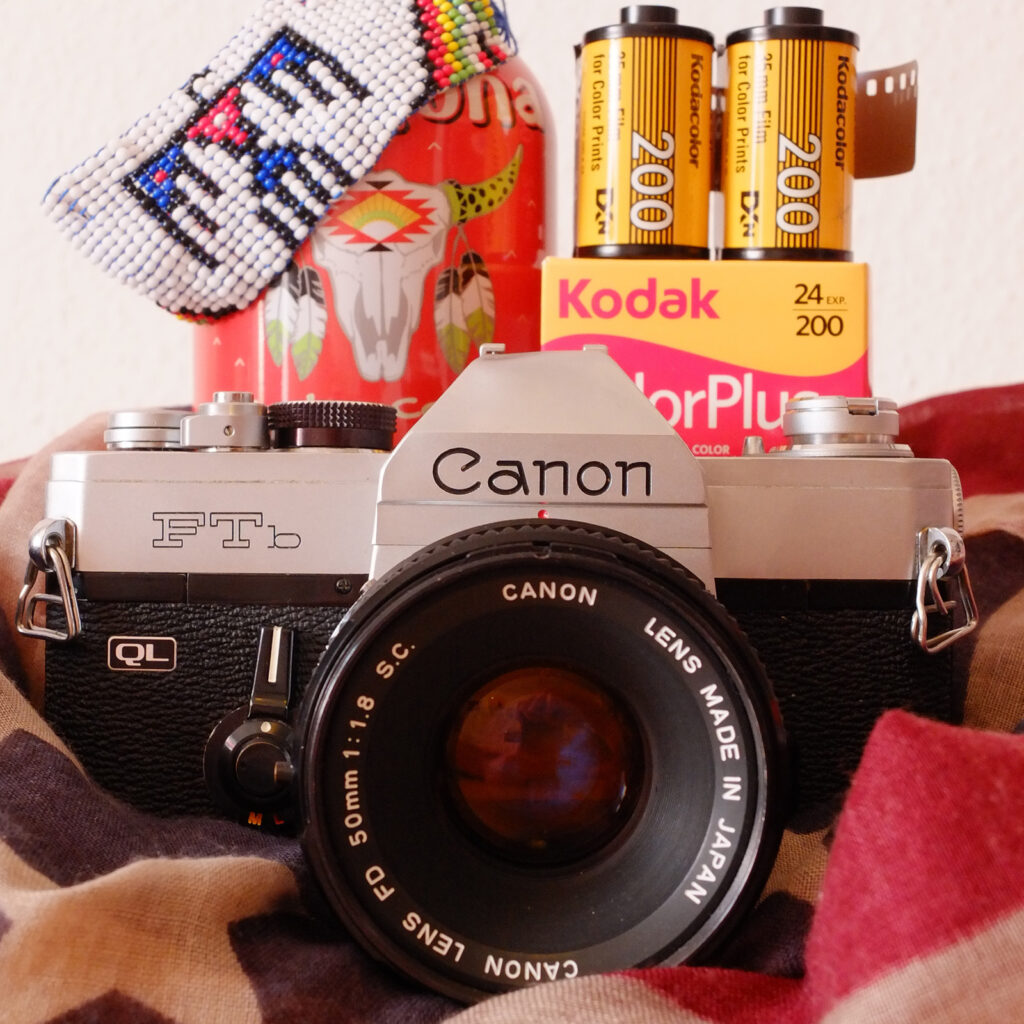
Vintage Lenses For Sony
Sony’s mirrorless system offers a perfect platform for photographers and videographers to experiment with vintage lenses. The blend of old-world charm with modern technology provides a unique opportunity to create distinctive visuals, making every shot a mixture of past and present.
Due to their mirrorless design and short flange distance, Sony E-mount cameras are particularly well-suited for adapting vintage lenses.
The Sony E-mount is one of the most adaptable mounts in modern photography. Its ability to quickly adapt to Canon EF lenses and other vintage lens mounts makes it a favorite among vintage lens enthusiasts.
Sony’s E-mount mirrorless cameras have a short flange distance, especially the full-frame Alpha series (like the A7, A9) and the APS-C series (like the A6000, A6400). This makes them highly adaptable to a wide variety of vintage lenses.
Advantages of Vintage Lenses on Sony: Sony E-mount cameras offer features like focus peaking and zebra patterns, which are invaluable when using manual vintage lenses. Focus peaking simplifies manual focusing, while zebra patterns help in proper exposure.
Sony E Mount Lens Adapters for Vintage Lenses
You’ll need an appropriate adapter to use vintage lenses on Sony cameras. Popular adapters include M42 to E-mount, Canon FD to E-mount, Nikon F to E-mount, and many others. These adapters are affordable and easy to find.
Some popular adapters include:
- FD to E-mount adapter
- C/Y to E-mount adapter
- M42 to E-mount adapter
- Pentax K to E-mount adapter
- Nikon F to E-mount adapter
- Minolta MD/SR to E-mount adapter
- Leica M and R to E-mount adapters
Recommended Vintage Lenses for Sony E-mount
- Canon nFD 35mm f/2.8: A sharp lens suitable for various photography styles.
- Canon nFD 85mm f/1.2 L: Comparable to Canon’s K35 vintage cinema lenses.
- Pentax SMC Takumar 20mm F/4.5: Offers a unique perspective effect.
- Vivitar Series 1 70-210mm f/3.5: A versatile lens with rich and saturated colors.
- Helios 44-2 58mm f/2: Known for its swirly bokeh and warm tones.
- Canon FD 50mm f/1.4: Offers sharpness and beautiful out-of-focus backgrounds.
- Minolta MD 35mm f/2.8: Renowned for its color rendition and contrast.
- Takumar 50mm f/1.4: A lens with a radioactive element, thorium, gives images a unique glow.
- Zeiss Contax 85mm f/2.8: Offers sharpness, micro-contrast, and a pleasing bokeh.
Best Vintage Lenses For Cinematography
Cinematography is a realm where the unique characteristics of vintage lenses can shine, offering a distinct look that modern lenses often can’t replicate. Vintage lenses offer a unique aesthetic that modern lenses often can’t replicate.
Their imperfections, such as scratches, dust, and bumps, contribute to the distinct character of the footage, making each shot unique.
Here’s a list of some of the best vintage lenses favored by cinematographers:
- Canon FD Line: Canon FD lenses are universally beloved for their affordability, ease of use, and the great-looking image they produce. They are particularly well-suited for Sony E-mounts and micro four-thirds cameras. The 24mm FD, when attached to a Metabones speedbooster on a Blackmagic Pocket Cinema Camera 4K, produces soft, dreamy, and warm images, perfect for capturing summer vibes.
- Canon FD 50mm f/1.4: Offers a sharp image with a beautiful bokeh.
- Canon FD 85mm f/1.2L: Renowned for its creamy bokeh and excellent low light performance.
- Zeiss Super Speeds: A set of prime lenses (18mm, 25mm, 35mm, 50mm, 85mm) that are fast and offer a cinematic look. They’re especially known for their sharpness and contrast.
- Zeiss Contax Series: Lenses like the 28mm f/2.8, 50mm f/1.4, and 85mm f/1.4 are known for their sharpness, contrast, and color rendition.
- Contax Zeiss 28mm f/2.8: This lens from the ’70s era offers a beautifully soft look, making it a delightful addition to a cinematographer’s kit. It’s designed for 35mm full-frame, making it compatible with the BMPCC6K’s Super 35mm sensor.
- Kowa Prominar Anamorphics: These are anamorphic lenses that provide a widescreen look with characteristic horizontal lens flares and oval bokeh.
- Nikon Nikkor f/1.4 AI-S Lineup: These lenses, initially designed for Nikon F2 stills cameras, are also excellent when adapted for video cameras. They offer a unique character, with the quality of the image being influenced by the condition of the lens.
- Nikkor 50mm f/1.4 AI-S: Offers sharpness with a cinematic quality.
- Nikkor 85mm f/1.4 AI-S: Known for its portrait capabilities and beautiful out-of-focus backgrounds.
- Cooke Speed Panchro: A series of prime lenses known for their “Cooke Look” which delivers warm skin tones and a smooth roll-off between highlights and shadows.
- Helios 44 58mm f/2: These lenses are known for their affordability, ruggedness, and speed. They can be modified to achieve various effects, making them versatile tools for cinematographers. They were designed for an M42 lens mount, so an adapter is required for modern cameras.
- Olympus Zuiko Lineup: While the author hasn’t personally used these lenses, they are highly recommended by many in the industry. The 100mm lens is particularly noted for its sharpness, but it comes at a higher price. These lenses are perfect for portraiture work, making them suitable for commercial and editorial projects.
- Bausch & Lomb Super Baltars: Used in classic Hollywood films, these lenses offer a warm, vintage look with unique flares.
- Angenieux Zoom Lenses: Lenses like the Angenieux 24-290mm offer versatility and a cinematic quality favored by many directors of photography.
Advice
When purchasing used gear, make sure you buy from a reputable source like KEH or a well-rated eBay seller. Services like BorrowedLenses and ShareGrid offer rental options for those who want to test a lens before committing to a purchase.
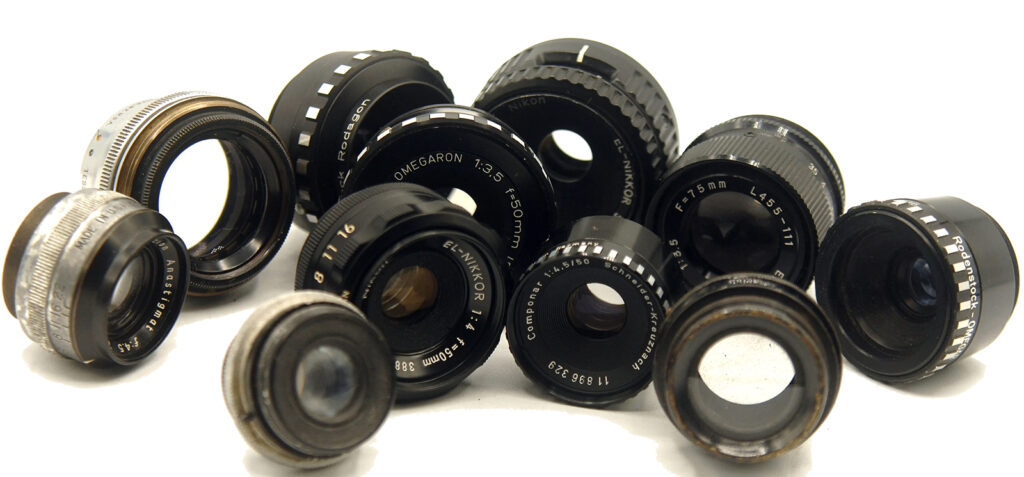
Purchasing Vintage Lenses: Finding Vintage Lenses For Sale
Vintage lenses offer a unique aesthetic that can’t be replicated by modern lenses. Their imperfections, such as dust, scratches, and bumps, contribute to the distinct character of the footage.
Here are some places to look for vintage lenses:
- Mom and Pop Camera Stores: Local camera stores are often treasure troves for vintage lenses. While they might have a slight markup compared to online prices, you get the convenience of trying out the lens on your camera and getting advice from experts.
- Estate Sales: Estate sales, especially those of older individuals or photographers, can be gold mines for vintage camera equipment. Keep an eye out for local listings.
- Online and Marketplace Options: For those without access to local camera stores, online platforms are the next best option. While you can’t test the lenses immediately, with patience and diligence, you can find quality vintage lenses. Some recommended platforms include:
- Mainstream Options: Ebay, Amazon, B&H
- Industry Options: LensAuthority, Keh, UsedPhotoPro
- Marketplace Options: Craigslist, Facebook Marketplace, ShopGoodwill
- Filmmaker Meetups: Engaging with other filmmakers can be a great way to discover vintage lenses. Many videographers have vintage lenses that they’ve found in attics, inherited from family members, or purchased at thrift shops. Some also buy them online, especially from eBay.
- Family and Friends: Ask around! You’d be surprised how many people have old camera equipment stored away in attics or basements. A family member or friend might have a vintage lens they’re willing to part with.
- Classified Ads: Local newspapers or bulletin boards in community centers might have listings for old camera equipment.
- Photography Shows & Expos: These events often have vendors selling vintage equipment. Even if you don’t find what you’re looking for, you can network with sellers who might have leads on where to find vintage lenses.
- Your Family’s Attic or Garage: Many filmmakers have discovered vintage lenses handed down by family members. These lenses often have personal significance and unique characteristics.
- Flea Markets & Antique Shops: These places often have stalls or sections dedicated to old electronics and camera equipment. It’s not uncommon to stumble upon a vintage lens or two.
- Pawn Shops: While they’re more hit-or-miss, pawn shops can sometimes have vintage lenses among their inventory.
- Camera Repair Shops: These places not only repair cameras but sometimes also sell used and vintage equipment. The owners might also know of local sellers or collectors.
- Networking: Talk to photographers, especially older ones. They might have or know someone who has vintage lenses for sale.
When buying a vintage lens, always check its condition. Look for mold, scratches, and ensure the aperture blades are working. If possible, test it out on your camera or a similar model before purchasing. Happy hunting!
Wrap Up
In the field of cinematography and videography, vintage lenses are more than just relics of the past; they are invaluable tools that breathe life, character, and a unique aesthetic into modern-day projects.
While discovering the perfect vintage lens might take one through local camera stores, online marketplaces, or even family attics, the reward is a lens with a story, a history, and an unmatched visual signature.
As technology continues to advance, remember and cherish the timeless beauty and artistry that vintage lenses bring to the table. Embracing vintage lenses can be a transformative experience, adding depth, warmth, and a touch of nostalgia to every frame.

